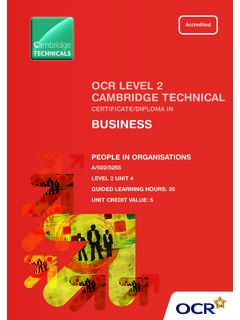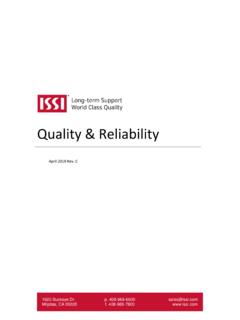Transcription of CERTIFICATE/DIPLOMA IN HEALTH AND SOCIAL …
1 OCR LEVEL 3 CAMBRIDGE TECHNICALCERTIFICATE/ diploma INHEALTH AND SOCIAL CAREPERSONALISATION IN HEALTH AND SOCIAL CAREM/505/7782 LEVEL 3 UNIT 30 GUIDED LEARNING HOURS: 60 UNIT CREDIT VALUE: IN HEALTH AND SOCIAL CAREM/505/7782 LEVEL 3 UNIT 30 AIM AND PURPOSE OF THE UNIT Since 2008 the Government s approach to care provision has been one of Personalised Care . This approach seeks to empower individuals and allow choice and control over the shape of their support within all care settings. It aims to provide direct payments to individuals so they can access the care and support they need. This unit gives learners the opportunity to study how personalisation supports choice and independence.
2 Learners will have the opportunity to examine how care services are commissioned and to investigate the success of the initiative throughout will gain an understanding of personalisation in care and will be able to recognise that individuals have control and choice when accessing support, funding and care. Learners will gain an understanding of the legislation that underpins personalisation of care and will be able to explore local and national initiatives and systems. Learners will gain knowledge in how payments are made to individuals and how this supports person centred care. Learners will have the opportunity to explore how personalisation affects the balance of power between the person receiving and providing care.
3 Learners will gain understanding of the skills, attitudes and approaches of those providing care and recognise how to overcome barriers to personalisation in HEALTH and SOCIAL in HEALTH and SOCIAL care Level 3 Unit 30 ASSESSMENT AND GRADING CRITERIAL earning Outcome (LO)The learner will:PassThe assessment criteria are the pass requirements for this unit. The learner can:MeritTo achieve a merit the evidence must show that, in addition to the pass criteria, the learner is able to:DistinctionTo achieve a distinction the evidence must show that, in addition to the pass and merit criteria, the learner is able to:1 Understand the concept of personalisation in HEALTH and SOCIAL careP1 define the term personalisation as it applies in HEALTH and SOCIAL careP2 explain the relationship between rights.
4 Choice and personalisationM1 explain how personalisation can benefit individualsD1 analyse the impact of personalisation on the care and support received by individualsP3 identify legislation related to personalisation in HEALTH and SOCIAL care2 Understand systems that support personalisation HEALTH and SOCIAL careP4 identify local and national systems that are designed to support personalisationP5 describe the process of commissioning SOCIAL careM2 explain how personalisation impacts on the process of commissioning SOCIAL careP6 explain how direct payments and individual budgets support personalisation3 Understand the impact of personalisation on the provision of care and supportP7 explain how personalisation is supported by person centred Outcome (LO)The learner will:PassThe assessment criteria are the pass requirements for this unit.
5 The learner can:MeritTo achieve a merit the evidence must show that, in addition to the pass criteria, the learner is able to:DistinctionTo achieve a distinction the evidence must show that, in addition to the pass and merit criteria, the learner is able to:P8 explain how personalisation affects the balance of power between the individual and those providing care and supportM3 analyse how personalisation affects the way individuals are Understand how personalisation is implemented in the context of HEALTH and SOCIAL careP9 identify skills, attitudes and approaches needed by those providing care or supportP10 explain how to overcome barriers to personalisation in a HEALTH or SOCIAL care CONTENTThe unit content describes what has to be taught to ensure that learners are able to access the highest which follows an details what must be taught as part of that area of which follows an is illustrative.
6 It should be noted that where is used, learners must know and be able to apply relevant examples to their work though these do not need to be the same ones specified in the unit Understand the concept of personalisation in HEALTH and SOCIAL care P1 Personalisation: Personalisation is defined broadly by central government as the way in which services are tailored to the needs and preferences of citizens. The overall vision is that the state should empower citizens to shape their own lives and the services they receive (HM Government Policy Review, 2007: p. 7)P2 Relationship: ( consider how conflict may arise between a person s rights and what they want and how the personalisation agenda impacts on this.)
7 Consider - direct payments, self assessment of needs, choice of services to accessed, choice of where and how care is provided, supporting the core care Benefit: ( individuals maintain control, able to remain in own home whilst receiving care, inclusion within the community, improved information and guidance)D1 Impact: Positive: ( direct payment for care allowing rapid access to services, inclusion within communities, preventing isolation. Remaining in own home where familiarity and sense of belonging add to quality of life. Access to information and guidance allowing better choices. Public service professionals should be available to users when the users want the service. Patient pathways in HEALTH care, children more choice over pace and style of learning in secondary education.)
8 Community safety initiatives, recuperative care programmes for the elderly and many welfare-to-work schemes)Negatives: Care limited to the prescribed budget. Availability and access to some services may be restricted in some legislation: HEALTH and SOCIAL Care Act 2008, Care Standards Act 2000, Local Authority Circular (DH) 2008 Personalisation Understand systems that support personalisation HEALTH and SOCIAL careP4 Systems: Local: ( Universal approaches designed for all HEALTH Promotion, Public Information, Localised Assessments on request, community transport, crisis support, safeguarding and carer support. Integrated HEALTH and SOCIAL care commissioning, information processing and resources.
9 Working closely with private and SOCIAL housing providers.)National: ( Decentralising of Authority, Flexible Resourcing, Appropriate co-ordination and variety of services, Government lead information and guidance. Qualified and suitably skilled workforce. Performance review and reform.)P5 Process of commissioning: Replaced Primary Care Trusts in April 2013, Controlling two-thirds of NHS budget and have a legal duty to support quality improvement in general practice. Must balance right investment between services and ensure value for money. Primary role is to make decisions about needs assessment, resource allocation service purchasing, monitoring and reviewing. Focus on effectiveness and efficiency.
10 7 step model for commissioning ( ). Identifying needs, Agreeing Key Priorities, Reviewing Strategic Arrangements, Pooling and Personalising budgets, Workforce development, Market and community development, Programme and Project Impact: Positive: ( Individuals needs determine how services are provided and maintained, Constant need for review and adaptation. Determines size and type of workforce needed in each area. Determines provision of effective community services and information.)Negative: ( Staff recruitment and retention within the care sectors may be difficult. Community infrastructure may not support all needs of care users. Higher demand on the Third Sector to support service users in the community.)












